News
GolfWRX takes a behind-the-scenes look at the Callaway ball plant

In Chicopee, Massachusetts, there is an unassuming red brick building that predates the existence of every modern golf OEM. From the outside, it could be confused for any other American manufacturing facility if not for the proudly displayed Callaway sign. Inside, there are over 400 hard-working people producing the highest quality golf balls using state-of-the art manufacturing techniques and tools — this red brick building is the Callaway golf ball plant.
To understand what you see when you first enter the ball plant, it’s best to first understand why it is here in the first place. When I initially asked this question to one of my tour guides, Vincent Simonds, the Senior Director of Global Golf Ball Operations, his answer started with a story that predated cars…it was at this point I knew that these guys mean business.
The modern history, however, starts in 2003 when Callaway purchased Top-Flite brand and subsidiaries, and with it purchased the entire Top-Flite manufacturing facility. In its it heyday, Top-Flite/Spaulding was producing its full line of clubs and balls out of this building, and that included equipment made for Bobby Jones. Chicopee, Massachusetts, was essentially the center of the golf club technology universe.

Part of the original Spaulding golf club factory
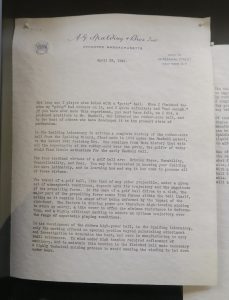
Letter from Bobby Jones discussing the advantage of the newly designed ball
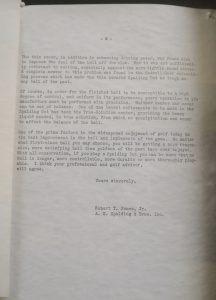
Page 2 of the Letter from Bobby Jones
When its comes to balls, most modern golfers don’t equate Top-Flite with premium equipment or breakthroughs, but during this time period the ball plant in Chicopee was responsible for just as many technology and scientific breakthroughs as its modern Callaway self.
One Example is Bob Molitor. In 1972, Molitor developed the first two-piece golf ball with a Surlyn cover by combining the right amounts of various ionomers. This allowed golf balls to have much greater durability and along with it improved distance. This development is part of the reason the USGA had to establish the “One Ball Rule” because players would switch out depending on the hole since there was a huge distance advantage to this Solid Core Surlyn Cover design. Imagine that – the USGA having to change rules to accommodate a new technology, seems to me our current daily discussions about bifurcation aren’t something so new after all.
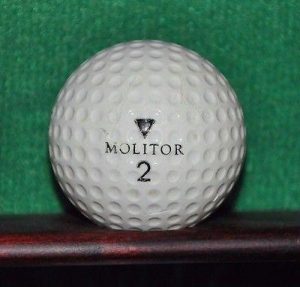
There were a lot of other great innovations over the years that lead to new technology making its way into the bags of players all over the world, one of which caused a revolution that we still benefit from today. In the 90s Top-Flite, under the Strata brand, cracked the code of merging the soft, high-spin “tour ball” performance with the lower-spinning, longer-flying, and more durable “distance ball”, this three-piece ball was like two balls in one. Strata’s design team accomplished this feat by placing a soft polyurethane cover on a Top-Flite distance ball, and then added a thin layer between the cover and the core that encased the ball’s already large and solid rubber core. In short, the modern golf ball was born.

This brings us back to the modern day Callaway ball plant, a facility where the average employee tenure exceeds 20 years, and where every single premium Callaway Ball on the planet is made. The thing I quickly realized upon entering the plant for the first time is the pride every person has for their role in making world class golf balls. This sense of pride, and a friendly, yet hard-working environment is something I witnessed before at Callaway’s Carlsbad facility too — a testament to the company’s corporate leadership and the culture that they promote everyday. The “Victory Flag,” as they call it, was flying high thanks to Xander Schauffele’s win just a few days before my visit.

The start of production begins with materials formulation
I was able to observe a pre-shift meeting, and you would think that based on the discussion of machine tolerances, quality control, & equipment inspections this plant is making parts for a yet-to-be-seen shuttle being sent into space, but they’re talking golf balls. Speaking to the tolerances the plant works within, the in-house machine shop had some amazing equipment, including some things I unfortunately could not share through pictures. This equipment works with the tolerances of less than the 1/30th the thickness of a Post-It Note. For example, each single side to a cover mold for the Chrome Soft line takes more than 30 hours of machine time to complete — an amount of time which might seem excessive, but when you think of the speed and forces impacting a golf ball from first driver strike and along its parabolic trajectory, we really are talking space shuttle physics.
Some of the most impressive equipment has nothing to do with the performance of the balls but rather how they look. I’m talking here about the Truvis patterned balls. What was perceived by many golfers at first as a gimmick (and something than even some Callaway management believed would be a fad) has proven to be an absolute slam dunk. The pentagon pattern provides a tangible benefit by creating an optical illusion that makes the ball look bigger (and easier to hit) especially out of the rough, and also gives visual feedback for short game shots and putting.
Let’s just say that what started as a toe dip with one machine has turned into an area of the plant with more than a dozen machines, and Callaway is also producing Truvis balls with custom colors and logos — they’re not just printing pentagons anymore.
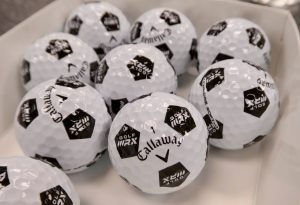
GolfWRX Truvis
For actual production, every ball starts as raw materials, and compounds are precisely mixed in house, allowing Callaway to control the entire production process. The amount of materials engineering and chemistry I witnessed was way beyond what I was expecting, and to be frank, I went in with already high expectations. After initial mixing each batch is tested and sent to the next step.
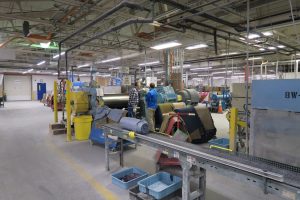
Mixing Station

Pre cut core “slugs” ready for baking
Ever wonder why the cores of various golf balls from a single OEM are so bright and differently colored? It’s actually done to make each material identifiable in the process and give production staff another way to make sure materials get to the right manufacturing line. Of all the questions I asked, this one had the most simple answer.
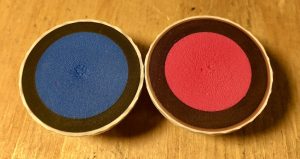
Callaway ERC ( Left ) vs. Chrome Soft ( Right )
The next step is the “cooking” process of the inner core. Each oven press is precisely controlled for pressure and temperature along multiple areas of each unit, this ensures a core that comes from the outer part of the press is formed and “cooked” to the exact same spec as one from the middle. The same process is used for both parts of the dual core.

Hydraulic press “oven” for producing cores
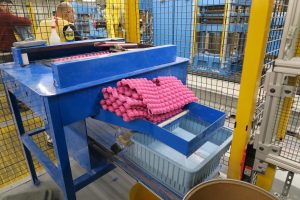
Cores post-pressing and still hot
Callaway utilized a proprietary manufacturing and molding technique to ensure exact specifications are met for centering the core and achieving correct cover thickness. Once the covers are in place, we officially have a golf ball, but we’re not done yet. There are still more quality control checks done by machine as well and humans to once again ensure each ball that leaves the plant is built to the highest quality standards and will perform just like the one before it.
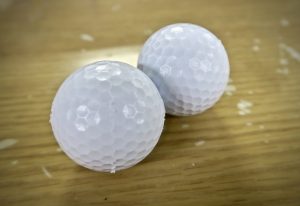
Chrome Softs just after the cover process – Still very warm to the touch as the urethane cools
Even the final paint and clear coat are highly engineered to resist staining, sheering, and stay on during deformation. To quote of one my tour guides, “The force applied to the cover and paint on the ball by a wedge would be like taking a hatchet to the paint on the side of your house.” It might seem like a simple process, but to ensure full coverage of sphere requires some pretty unique tools to get the job done.
This brings us to the new Triple Track Alignment system and how it was developed to help golfers play better. The new system helps improve alignment on putts from all lengths and it also happens to be on Callaway’s longest ball to date: the ERC Soft.
The alignment aid wraps 160 degrees around the ball and offers three parallel lines with high contrast (no more need to try and draw that long Sharpie line around your ball). For those who choose to putt without the Triple Track alignment, Callaway considered you too, since the other 200 degrees around the ball unsure that you won’t see those lines from address.
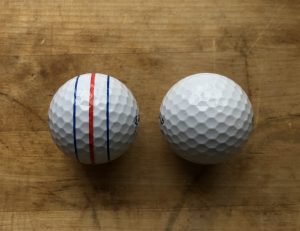
Triple Track Alignment visible vs hidden
Every shot taken means something to someone, whether it be a golfer trying to break 100 for the first time, or a tour professional lining up a putt on Sunday afternoon of a major championship. The golf ball is the one piece of equipment a golfer will use on every shot, and each person at the Callaway ball plant in Chicopee, Massachusetts, is proud to put their name behind it, even if you don’t see those names on the box.
News
Tour Rundown: Bend, but don’t break

I’m going to gush in this intro paragraph, to get the emo stuff done early. I’ve not pulled harder for a professional to win, than Cameron Young. I coach golf in New York state, and each spring, my best golfers head to a state championship in Poughkeepsie. I first saw Cameron there as a 9th grade student. I saw him three more times after that. I reconnecected with Coach Haas from Wake Forest, an old interview subject from my days on the Old Gold and Black, the Wake newspaper. He was there to watch Cameron. After four years at Wake Forest, Young won on the Korn Ferry Tour, made it to the big tour, almost won two majors, almost won five other events, and finally got the chalice about 25 minutes from the Wake campus. Congratulations, Cameron. You truly are a glass of the finest. #MotherSoDear
OK, let’s move on to the Tour Rundown. The major championship season closed this week in Wales, with the Women’s Open championship. The PGA Tour bounced through Greensboror, N.C., while the PGA Tour Americas hit TO (aka, Toronto) for a long-winded event. The Korn Ferry lads made a stop in Utah, one of just two events for that tour in August. The many-events, golf season is winding down, as we ease from summer toward fall in the northern hemisphere. Let’s bask in the glory of an August sunrise, and run down a quartet of events from the first weekend of the eighth month.
LET/LPGA @ Women’s Open: Miyu bends, but she doesn’t break
Royal Porthcawl was not a known commodity in the major tournament community. The Welsh links had served as host to men’s senior opens, men’s amateurs, and Curtis and Walker Cups in prior years, but never an Open championship for the women or the men. The last-kept secret in UK golf was revealed once again to the world this week, as the best female golfers took to the sandy stage.
Mao Saigo, Grace Kim, Maja Stark, and Minjee Lee hoped to add a second major title to previous wins this season, but only Lee was able to finish inside the top ten. The 2025 playing of the Women’s Open gave us a new-faces gallery from day one. The Kordas and Thitikulls were nowhere to be found, and it was the Mayashitas, Katsus, and Lim Kims that secured the Cymru spotlight. The first round lead was held at 67 by two golfers. One of them battled to the end, while the other posted 81 on day two, and missed the cut. Sitting one shot behind was Miyu Yamashita.
On day two, Yamashita posted the round of the tournament. Her 65 moved her to the front of the aisle, in just her fourth turn around a women’s Open championship. With the pre-event favorites drifting off pace, followers narrowed into two camps: those on the side of an underdog, and others hoping for a weekend charge from back in the pack. In the end, we had a bit of both.
On Saturday, Yamashita bent with 74 on Saturday, offering rays of hope to her pursuing pack. England’s Charley Hull made a run on Sunday closing within one shot before tailing off to a T2 finish with Minami Katsu. Katsu posted the other 65 of the week, on Saturday, but could not overtake her countrywoman, Yamashita. wunderkind Lottie Woad needed one round in the 60s to find her pace, but could only must close-to’s, ending on 284 and a tie with Minjee for eighth.
On Sunday, Yamashita put away the thoughts of Saturday’s struggles, with three-under 33 on the outward half. She closed in plus-one 37, but still won by two, for a first Major and LPGA title.
PGA Tour @ Wyndham: Young gathers first title near home
Cameron Young grew up along the Hudson river, above metro New York, but he also calls Winston-Salem home. He spent four years as a student and athlete at Wake Forest University, then embarked on tour. This week in Greensboro, after a bit of a break, Young opened with 63-62, and revved the engine of Is this the week once more. Runner-up finishes at the Open, the PGA, and a handful of PGA Tour events had followers wonder when the day would come.
On Saturday, Young continued his torrid pace with 65, giving him a five-shot advantage over his closest pursuer. Sunday saw the Scarborough native open with bogey, then reel off five consecutive birdies to remind folks that his time had, at last, arrived. Pars to the 16th, before two harmless bogeys coming home, made Young the 1000th winner of an official PGA Tour event (dating back to before there was a PGA Tour) throughout history. What’s next? I have a suspicion, but I’m not letting on. Mac Meissner closed with 66 to finish solo 2nd, while Mark Hubbard and Alex Noren tied for third.
Korn Ferry Tour @ Utah Championship: Are you Suri it’s Julian?
Who knows exactly when the flower will bloom? Julian Suri played a solid careet at Duke University, then paid his dues on the world’s minor tours for three years. He won twice on two tours in Europe, in 2017. Since then, the grind has continued for the journeyman from New York city. At age 34, Suri broke through in Beehive state, outlasting another grinder (Spencer Levin) and four others, by two shots.
Taylor Montgomery began the week with 62, then posted 64, then 68, and finally, 70. That final round was his undoing. He finished in that second-place tie, two back of the leader. Trace Crowe, Barend Botha, and Kensei Hirata made up the last of the almost quintet. As for Suri, his Sunday play was sublime. His nines were 32 and 31, with his only radar blip a bogey at ten. He closed in style with one final birdie, to double his winning margin. Hogan bloomed late…might Suri?
PGA Tour Americas @ Osprey Valley Open presented by Votorantim Cimentos – CBM Aggregates
Some tournament names run longer than others. This week in Toronto, at the Heathlands course at TPC Toronto, we might have seen the longest tournament title in recorded history. The OVOPBVCCBMA was a splendid affair. It saw three rounds of 62 on Thursday, but of those early risers, only Drew Goodman would stick around until the end. 64 was the low tally on day two, and two of those legionnaires managed to finish inside the top three at week’s end. Saturday brought a 63 from Patrick Newcomb, and he would follow with 64 on Sunday, to finish solo fourth.
Who, then, ended up winning the acronym of the year? It turns out that Carson Bacha had the right stuff in TeeOhhh. Bacha and Jay Card III posted 63 and 64, respectively, on day four, to tie for medalist honors at 23-under 261. Nathan Franks was one shot adrift, despite also closing with 63. If you didn’t go low on Sunday, it was about the check, not the championship.
Bacha and JC3 returned to the 18th hole twice in overtime. Card nearly chipped in from the thick stuff for birdie, while Bacha peeked and shoved a ten-feet attempt at the win. On the second go-round, Card was long with his approach, into the native grasses once more. He was unable to escape, and a routine par from the fairway was enough to earn the former Auburn golfers a first KFT title.
Card III and Bacha both miss their birdie tries on the first playoff hole.
We’ll play 18 again @OspreyOpen. pic.twitter.com/vNpHTdkHDg
— PGA TOUR Americas (@PGATOURAmericas) August 3, 2025
Tour Photo Galleries
Photos from the 2025 Wyndham Championship
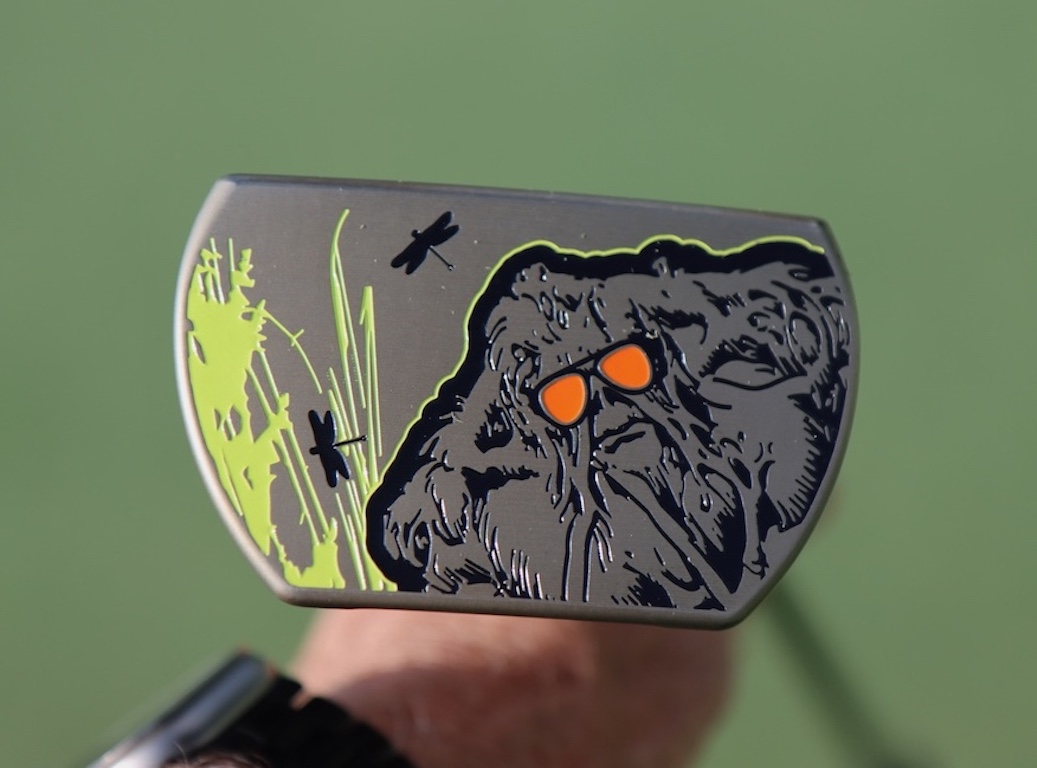
GolfWRX is live this week from the final event of the PGA Tour’s regular season, the Wyndham Championship.
Photos are flowing into the forums from Sedgefield Country Club, where we already have a GolfWRX spirit animal Adam Schenk WITB and plenty of putters for your viewing pleasure.
Check out links to all our photos below, which we’ll continue to update as more arrive.

General Albums
- 2025 Wyndham Championship – Tuesday #1
- 2025 Wyndham Championship – Tuesday #2
- 2025 Wyndham Championship – Tuesday #3

WITB Albums
- Chandler Phillips – WITB – 2025 Wyndham Championship
- Davis Riley – WITB – 2025 Wyndham Championship
- Scotty Kennon – WITB – 2025 Wyndham Championship
- Austin Duncan – WITB – 2025 Wyndham Championship
- Will Chandler – WITB – 2025 Wyndham Championship
- Kevin Roy – WITB – 2025 Wyndham Championship
- Ben Griffin – WITB – 2025 Wyndham Championship
- Peter Malnati – WITB – 2025 Wyndham Championship
- Ryan Gerard – WITB – 2025 Wyndham Championship
- Adam Schenk – WITB – 2025 Wyndham Championship
- Kurt Kitayama – WITB – 2025 Wyndham Championship
- Camilo Villegas – WITB – 2025 Wyndham Championship
- Matti Schmid – WITB – 2025 Wyndham Championship
Pullout Albums
- Denny McCarthy’s custom Cameron putters – 2025 Wyndham Championship
- Swag Golf putters – 2025 Wyndham Championship
- Karl Vilips TM MG5 wedges – 2025 Wyndham Championship
- New Bettinardi putters – 2025 Wyndham Championship
- Matt Fitzpatrick’s custom Bettinardi putters – 2025 Wyndham Championship
- Cameron putters – 2025 Wyndham Championship

See what GolfWRXers are saying and join the discussion in the forums.
News
BK’s Breakdowns: Kurt Kitayama’s Winning WITB, 3M Open

Kurt Kitayama just won his 2nd PGA Tour event at the 3M Open. Kurt is a Bridgestone staffer but with just the ball and bag. Here are the rest of the clubs he used to secure a win at the 2025 3M Open.
Driver: Titleist GT3 (11 degrees, D1 SureFit setting)
Shaft: Graphite Design Tour AD VF 7 TX
3-wood: Titleist GT1 3Tour (14.5 degrees, A3 SureFit setting)
Shaft: Graphite Design Tour AD DI 8 TX
7-wood: Titleist GT1 (21 degrees, A1 SureFit setting)
Shaft: Graphite Design Tour AD DI 9 TX
Irons: TaylorMade P7CB (4), TaylorMade P7MB (5-PW)
Shafts: True Temper Dynamic Gold Tour Issue X100
Wedges: Titleist Vokey Design SM10 (52-12F, 56-14F), Vokey Design WedgeWorks (60-K*)
Shafts: True Temper Dynamic Gold Tour Issue S400
Putter: Scotty Cameron Studio Style Newport 2 Tour Prototype
Grip: SuperStroke Zenergy 1.0PT
Grips: Golf Pride Tour Velvet
Ball: Bridgestone Tour B XS (with Mindset)




















DanT
Mar 14, 2019 at 7:52 pm
PROBLEM – NOT ALL CALLAWAY BALLS ARE PRODUCED IN THE US!!
The SuperSoft is made in Taiwan!!
In my opinion – this story makes you think – all Callaway balls are made in the US –WRONG!!
Perplexed
Jan 20, 2019 at 1:08 pm
Did the USGA come up with the one ball rule? I don’t recall having ever seen it in the USGA rules. It seemed like a PGA Tour rule to me.
Mark
Jan 19, 2019 at 11:26 am
I’m curious if you asked if they run special batches for their tour players and what % play one of the standard production balls?
Willie Carmichael
Jan 19, 2019 at 11:01 am
It’s spelled Spalding.
Bill C
Jan 19, 2019 at 8:58 am
Golf balls are very fascinating. They seem so simple, yet the amount of engineering which goes into their design and manufacture always amazes me.